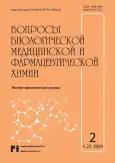Валидационная оценка методики количественного определения α(1,2)-l-рамно-α(1,4)-d-галактопиранозилуронана acorus calamus l. В готовой лекарственной форме
- Авторы: Зыкова А.В.1, Исаков Д.А.1, Кривощеков С.В.1
-
Учреждения:
- Сибирский государственный медицинский университет Министерства здравоохранения Российской Федерации
- Выпуск: Том 27, № 2 (2024)
- Страницы: 57-61
- Раздел: Фармацевтическая химия
- URL: https://journals.eco-vector.com/1560-9596/article/view/627118
- DOI: https://doi.org/10.29296/25877313-2024-02-07
- ID: 627118
Цитировать
Полный текст
Аннотация
Введение. Объектом внимания исследователей является аир болотный (Acorus calamus L.), для компонентов которого выявлен широкий спектр фармакологической активности – иммуномодулирующей, противовоспалительной, анальгетической, антиоксидантной, нейропротективной, гиполипидемической, противоопухолевой. Согласно ранее проведенным исследованиям, выявлено, что α(1,2)-L-рамно-α(1,4)-D-галактопиранозилуронан, выделенный из корневищ Acorus calamus L., обладает антиметастатическими, антибластомными, иммуномодулирующими свойствами. Вещество способно также снижать токсическое воздействие на гемопоэтическую систему и повышать эффективность химиотерапии. На его основе получена готовая лекарственная форма – раствор для внутривенного введения 10 мг/мл, требующая разработки валидных методик контроля качества для включения в проект нормативной документации по качеству и регистрации нового лекарственного препарата.
Цель исследования – определение метрологических характеристик хроматографической методики количественного определения α(1,2)-L-рамно-α(1,4)-D-галактопиранозилуронана в готовой лекарственной форме.
Материал и методы. Объектом исследования служила готовая лекарственная форма – раствор для внутривенного введения α(1,2)-L-рамно-α(1,4)-D-галактопиранозилуронана Acorus calamus L. 10 мг/мл, произведенная на базе ОПУ ЦВТ ФГБОУ ВО СибГМУ Минздрава России. Количественное определение исследуемого вещества осуществляли с помощью жидкостного хроматографа Dionex Ultimate 3000 («Thermo», Германия) с рефрактометрическим детектором RI-101. Валидационную оценку проводили по следующим показателям: линейность, правильность, прецизионность.
Результаты. Линейный регрессионный анализ полученных результатов методом наименьших квадратов показал, что методика линейна в диапазоне концентраций 80–120%. При определении правильности открываемость для концентраций 80, 100 и 120% варьировала в диапазоне 99,68–101,96%. Значения относительного стандартного отклонения не превышали допустимых значений при оценке прецизионности 0,82–4,51%.
Выводы. Методика валидирована по исследуемым показателям и может быть рекомендована для включения в фармакопейную статью предприятия.
Ключевые слова
Полный текст
Об авторах
А. В. Зыкова
Сибирский государственный медицинский университет Министерства здравоохранения Российской Федерации
Автор, ответственный за переписку.
Email: anastasya.zykova@mail.ru
аспирант, кафедра фармацевтического анализа
Россия, ТомскД. А. Исаков
Сибирский государственный медицинский университет Министерства здравоохранения Российской Федерации
Email: anastasya.zykova@mail.ru
аспирант, кафедра фармацевтического анализа
Россия, ТомскС. В. Кривощеков
Сибирский государственный медицинский университет Министерства здравоохранения Российской Федерации
Email: anastasya.zykova@mail.ru
к.х.н., доцент, кафедра фармацевтического анализа
Россия, ТомскСписок литературы
- Khan M.A., Islam M.T. Analgesic and cytotoxic activity of Acorus calamus L., Kigelia pinnata L., Mangifera indica L. and Tabernaemontana divaricata L. J Pharm Bioallied Sci. 2012; 4(2): 149–154.
- Muthuraman A., Singh N. Attenuating effect of Acorus calamus extract in chronic constriction injury induced neuropathic pain in rats: an evidence of anti-oxidative, anti-inflammatory, neuroprotective and calcium inhibitory effects. BMC Complement Altern Med. 2011; 11: 24.
- Parab R.S., Mengi S.A. Hypolipidemic activity of Acorus calamus L. in rats. Fitoterapia. 2002; 73(6): 451–455.
- Rahamooz Haghighi S., Asadi M.H., Akrami H., Baghizadeh A. Anti-carcinogenic and anti-angiogenic properties of the extracts of Acorus calamus on gastric cancer cells. Avicenna J Phytomed. 2017; 7(2): 145–156.
- Lopatina K.A., Safonova E.A., Nevskaya K.V., et al. Effect of Acorus calamus L. Polysaccharide on CD274 and CD326 Expression by Lewis Lung Carcinoma Cells in Mice. Bull Exp Biol Med. 2017; 164(1): 102–105.
- Лопатина К. А., Гурьев А. М., Разина Т. Г., Амосова и др. Действие водорастворимых полисахаридов корневищ аира болотного на функциональную активность клеток лимфоузлов в условиях цитостатической терапии перевиваемой опухоли. Сибирский онкологический журнал. 2006; 3: 59–63.
- Сафонова Е.А., Разина Т.Г., Лопатина К.А., и др. Снижение токсического эффекта паклитаксела на систему крови водорастворимыми полисахаридами мать-и-мачехи обыкновенной и аира болотного. Сибирский онкологический журнал. 2010; 2: 42–46.
- Сафонова Е.А., Гурьев А.М., Разина Т.Г. и др. Повышение эффективности химиотерапии с помощью фармакологически активных фракций, выделенных из полисахаридного комплекса аира болотного (Acorus calamus L.). Российский биотерапевтический журнал. 2012; 11(4): 55–58.
- Неупокоева О.В., Лопатина К.А., Воронова О.Л. и др. Изучение мутагенных свойств а(1,2)-1-рамно-а(1,4)-D-галактопиранозилуронана Acorus calamus L. ТМЖ. 2015; 2(60): 22–23.
- Nasir O. Protective effect of Acorus calamus on kidney and liver functions in healthy mice. Saudi J Biol Sci. 2021; 28(5): 2701–2708.
- Государственная фармакопея Российской Федерации XV изд. ОФС.1.1.0012 Валидация аналитических методик. [Электронное издание]. Режим доступа: https://pharmaco-poeia.regmed.ru/pharmacopoeia/izdanie-15/?PAGEN_1=5
- Ершик В.М., Жебентяев А.И., Фадеев В.И., Ершик О.А. Валидация методики количественного определения метопролола в плазме крови. Вестник фармации. 2011; 3 (53): 51– 56.
Дополнительные файлы







